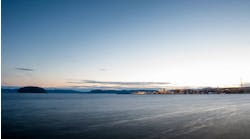Dengliang Gao
Marathon Oil
In the petroleum industry, exploration geo-logists confront two major challenges. The first is to investigate structure and strati-graphy deeply buried in the subsurface, particularly in frontier sedimentary basins where little geological data is available. Second, the discontinuous nature, limited extent, and dimension of the data, obtained from drilling operations, make it difficult to map detailed lateral and vertical changes in structure and stratigraphy on a regional basis.
Combating the difficulties of mapping deep structure and stratigraphy and extrapolating well bore information requires reliance on seismic technologies. These allow geologists to extract structural and stratigraphic information from reflection seismic in an efficient and objective manner. Seismic texture analysis provides one effective solution to these problems.
Concepts
A seismic image is characterized by a series of wiggle traces with alternating peak and trough amplitudes aligned laterally to form a stratal reflection pattern. A seismic texture is defined by both the magnitude and variation of amplitude along or across the wiggle traces. Unlike visualizing seismic data based on a picture element (pixel) or a volume picture element (voxel) in 2D or 3D space, characterizing seismic features is achieved based on a textural element (texel) that includes an array of neighboring data samples.
There are a number of algorithms that have been successfully applied to characterizing texels.These algorithms are divided into two general categories here, based on the fundamental differences in methodology.
Texture attribute extraction
The texture attribute extraction (TAE) process is a classical approach to characterizing textures by calculating a plurality of attributes from the original amplitude. Although many different textural extraction algorithms have been published since the early 1970s, they have been primarily applied to 2D images, but little has been published on their applicability to 3D reflection seismic.
Based on comparative studies, the author found that those extracted via the orientation sensitive, point-relational algorithms, such as homogeneity, contrast, and randomness are particularly effective in characterizing the inter- and intra-trace variations in reflection seismic amplitude. The texture extraction method is also inclusive of certain classical seismic attribute extraction algorithms that capture spatial and temporal variations in amplitude.
Examples include coherence, which evaluates inter-trace similarity in waveform, and waveform curvature that extracts the intra-trace variation in amplitude by calculating the second derivative of amplitude with time. Since each extraction algorithm generally highlights a specific aspect of a seismic reflection pattern, a combination of multiple attributes helps minimize the non-uniqueness in attribute interpretation and extrapolation.
Texture model regression
The texture model regression (TMR) methodology was recently developed by the author to discriminate seismic features in a more effective manner. Using a static or dynamic texture model as a running calibration filter, the process directly transforms the original amplitude data into a geologically more meaningful result. From the TMR methodology, two major algorithms, the structure and facies filters, were developed.
The structure filter is designed to retain and enhance the coherence, the discontinuities, and the contrast of reflection events that are best expressed in the cross-sectional (profile) view. It provides a synoptic view for faults, fractures, shear zones, folds, etc., and is different from the classical attribute extraction algorithms that attempt to highlight a specific aspect of the seismic texture at the expense of sacrificing useful structural information.
Such a view helps geologists better understand not just the geometry, but also the kinematics of the structural features, both of which are fundamental to investigating deformational mechanisms and tectonic history.
The second texel filter, the facies filter, is designed to optimize and facilitate seismic facies analysis from the map view. It directly transforms the original amplitude volume into a thematic feature volume. Such a volume significantly enhances geologists' ability to visualize and map seismic facies variation more interactively and objectively than classical methodologies.
Although seismic facies may not necessarily be equivalent to geological facies due to the resolution limitations and non-uniqueness of reflection seismic data, the facies cube provides a new perspective for interpreting and mapping critical depositional facies elements in the subsurface.
Summary
There are significant differences in process between the TAE and the TMR methodologies. This categorization helps better define the functionalities of various seismic texture algorithms to improve geologists' ability to visualize, map, and interpret seismic features.
Computer-aided seismic texture analysis, integrated with interpreter-driven, geology-oriented constructional synthesis of all the available data sets, provides an effective solution to overcoming the two major challenges facing exploration geologists. Overcoming these challenges is fundamental to successful hydrocarbon exploration.
Acknowledgments
The author thanks Marathon Oil Corporation for permission to publish this paper. Thanks to Sharon Crawford and Tom Evans of Marathon for their support of this study and their suggestions. The 3D seismic data used in this paper was provided courtesy of the Bureau of Economic Geology, Austin, Texas.
References
For a complete set of references, please contact the author at Marathon Oil.




